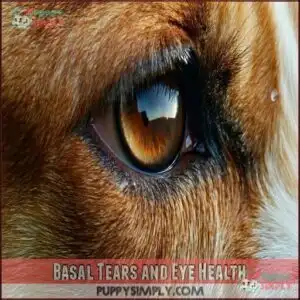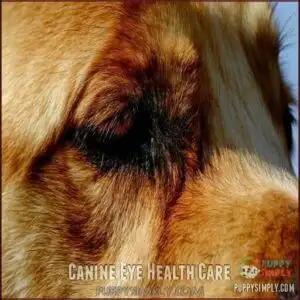This site is supported by our readers. We may earn a commission, at no cost to you, if you purchase through links.

Tears keep your pup’s eyes moist and free of irritants, like dust or allergens.
If you see watery eyes, it could mean their tear ducts are blocked, or they might have an eye issue like conjunctivitis or allergies.
While dogs express emotions through body language and sounds, they don’t shed tears when they’re sad or happy.
Think of tears as your dog’s built-in windshield wiper system. If their eyes seem especially watery, it’s worth checking with a vet to rule out any underlying problems, and consider the importance of their tear ducts.
Table Of Contents
Key Takeaways
- Dogs don’t cry emotional tears like humans; their tear ducts are designed to keep their eyes clean, moist, and healthy eyes.
- If your dog’s eyes are watery, it’s likely due to allergies or irritants, blocked tear ducts, or an eye infection, not sadness or joy.
- Excessive tear production during reunions is tied to oxytocin levels, showcasing excitement and attachment rather than emotional crying.
- Regular eye care and prompt veterinary attention help maintain your dog’s eye health and prevent potential issues like infections or blockages.
Can Dogs Cry Tears
You might wonder if your dog’s tears mean they’re sad, but it’s not that simple.
Dogs produce tears to maintain eye health, not as an emotional response like humans do, which is a complete concept to understand about canine behavior.
Dogs shed tears for health, not heartbreak—a fascinating difference in canine behavior worth understanding.
Tear Duct Function
Dog tears serve an essential purpose, but not the way you might think.
Tear ducts drain tears toward the throat and nose, ensuring moisture and eye cleanliness. The tear film, created during tear secretion, protects against dryness and debris.
This lubrication process keeps eyes healthy. When tear drainage fails, it can cause epiphora, leading to irritation and excess moisture.
Duct anatomy plays a key role in the overall process, and understanding it is crucial for maintaining healthy eyes and preventing issues related to tear drainage.
Eye Health and Tear Production
Tear ducts don’t just exist for show—they’re essential for your dog’s eye health.
By creating basal tears, they keep the eye hydrated, while reflex tears flush out irritants like dust.
The tear film layers work together for proper canine eye lubrication, preventing dryness.
If tears overflow, though, it may signal problems like epiphora or blocked tear ducts needing attention.
Physiological Response to Emotions
It’s fascinating how reconnecting with you can spark a physiological twist in their dog tear ducts.
Dogs produce more tears during emotional moments like reunions, driven by oxytocin tears, a hormone influence that deepens bonds.
Unlike emotional tears in humans:
- Canine tears lack emotional equivalence.
- Reunions can evoke this tear response.
- Hormonal shifts explain increased tear volume.
- Physical signals reflect dog emotions.
- Canine tears serve functional, not emotional, roles.
The key difference lies in the role of tears, with canine tears serving functional purposes, and the response being triggered by hormonal shifts.
Do Dogs Cry Tears
You might wonder if dogs cry tears like humans, but the short answer is no.
While their eyes can water due to health issues like blocked tear ducts or allergies, these tears aren’t tied to emotions.
Blockage of Tear Ducts
Blocked tear ducts can lead to epiphora, causing watery eyes and discomfort.
Common causes include inflammation or injury. Symptoms might show as constant dampness around your dog’s eyes.
Diagnosis often needs a vet to rule out serious eye problems. Treatment could involve flushing the ducts or other medical solutions.
Regular checkups and proper eye health care help prevent this issue.
Corneal Ulcer
Dealing with a corneal ulcer can be tricky for your dog. Symptoms include watery eyes, squinting, and pawing at the face.
Causes might include trauma, scratches, or infections.
Here’s what you can do:
- Watch for signs of eye irritation or redness.
- Get prompt veterinary care to avoid complications.
- Follow prescribed treatments carefully.
- Use preventative measures like trimming fur.
Early veterinary intervention can also help prevent miscellaneous health concerns from escalating, which is crucial for your dog’s health and can help with preventing complications.
Eye Infection
An eye infection can make your dog’s eyes feel irritated, leading to redness, swelling, and watery discharge.
Infection causes range from bacteria to underlying dog eye problems like untreated allergies.
You’ll notice symptoms such as yellow mucus or extreme eye irritation.
Treatment options depend on veterinary care, so call your vet immediately.
Prompt attention prevents complications and keeps your pup comfortable.
Treatment should be guided by a professional to address the root cause of the infection, ensuring your dog receives the appropriate treatment.
Conjunctivitis
Conjunctivitis, also known as pink eye, is a common dog eye problem caused by allergies, infections, or blocked tear ducts.
Watch for redness, swelling, or discharge around your pup’s eyes.
- Puffy, red membranes that look inflamed
- Yellow or green discharge from the corners
- Excessive blinking or pawing at the eyes
Quick treatment prevents complications and restores your dog’s eye health!
Allergies
Allergies can leave your dog with weepy eyes and wet fur.
From seasonal allergies like pollen to food allergies, pinpointing the culprit is key. Allergy symptoms include redness, swelling, and excessive tearing.
Without treatment, these can mimic an eye infection. Try allergen identification or allergy treatment, but if tears persist, consult a vet to keep your dog’s health in check.
Dog Tear Production
Dogs produce tears to keep their eyes clean, moist, and healthy. These tears play a vital role in protecting the surface of the eye and washing away irritants.
Basal Tears and Eye Health
Basal tears are essential for keeping your dog’s eyes healthy and comfortable.
They maintain the tear film, ensuring eye lubrication while supporting the ocular surface.
These tears supply essential nutrients, remove debris, and protect against dryness.
Without them, issues like wet eyes, allergies, or even an eye infection can develop.
Tear ducts work quietly, guarding your pup’s vision with steady maintenance and care.
Reflex Tears and Irritants
When your dog’s tear ducts go into overdrive, they’re likely responding to irritants like dust or foreign particles.
Dogs’ tear ducts protect their eyes, flushing out irritants like dust while keeping them clean and healthy.
Reflex tears help with Dust Removal and Allergen Flush, keeping the cornea protected and moist.
This natural Irritant Response prevents damage like scratched corneas.
If watery eyes persist or appear with swelling, a vet check is essential to rule out an eye infection.
Tear Volume and Oxytocin Release
Reflex tears protect your dog from irritants, but something incredible happens during reunions with you.
Studies in Current Biology reveal oxytocin effects on tear production, increasing tear volume when emotions soar.
This isn’t sadness, though—it strengthens the emotional connection between you and your dog.
These reunion tears may act as a social signal, enhancing human perception of their emotions and deepening bonds.
Reasons for Dog Tears
Dogs’ tears usually point to something physical, like allergies or eye irritation.
Whether it’s a blocked tear duct, an infection, or a simple speck of dirt, understanding the cause is essential for their comfort and health.
Allergies and Watery Eyes
Sometimes, watery eyes in dogs are linked to allergies.
Whether it’s environmental allergens like pollen or food allergies, these can cause irritation, redness, and weepy eyes.
Allergy symptoms could include increased tear production, which looks like your dog has been crying.
Identifying the allergen and seeking allergy treatment can make a big difference, and managing triggers helps prevent discomfort or conditions like conjunctivitis.
Effective solutions include dog allergy relief.
Blocked Tear Ducts and Eye Infections
Ever wonder why your dog has weepy eyes?
Blocked tear ducts or eye infections could be the culprits. Infection symptoms like redness, swelling, or unusual discharge need prompt veterinary care.
Blockage causes range from inflammation to debris buildup. Regular preventative cleaning helps, but untreated cases risk developing conditions like conjunctivitis or even a corneal ulcer.
Early treatment guarantees healthier, happy eyes.
Speck of Dirt in The Eye or Scratched Cornea
A scratched cornea or a speck of dirt can cause your dog to have weepy eyes, leading to discomfort and increased tear production.
You might notice excessive blinking or pawing at the eye—actions that might worsen the issue.
Keep preventative eye cleaning in mind, but don’t wait if symptoms persist, as veterinary intervention is needed to avoid complications like corneal ulcers or conjunctivitis.
If redness is also present, your dog may have canine conjunctivitis.
Dog Emotional Expression
Dogs have many ways to show how they’re feeling, but tears aren’t one of them.
Instead, they express emotions through body language, vocalizations, and behaviors like whimpering or hiding.
Body Language Cues
Dogs reveal emotions through clear body language cues.
Understanding these signs helps you connect with their feelings.
Watch for:
- Tail wagging: A happy or excited signal, but stiff, slow wags can mean caution.
- Ear position: Raised ears show curiosity; flattened ears may indicate fear.
- Facial expressions: Relaxed dogs might "smile," while intense eye contact signals focus.
Reading canine behavior deepens your bond through shared understanding.
Vocalizations and Communication
Dogs communicate in ways you can hear as much as you can see.
Each sound carries meaning: whining often signals a need, barking varies between excitement and alertness, and growling points to unease.
Notably, dog vocalizations differ by breed, from expressive puppy sounds to muffled tones.
Use this quick guide to decode common behaviors:
The table provides a clear overview of the different vocalization types, their meanings, and common situations in which they occur, helping to understand dog communication and behavioral patterns.
Whimpering, Shaking, and Hiding
Whimpering, shaking, and hiding aren’t just random behaviors—they’re clear communication signals.
When fear or stress strikes, sensitive dogs often seek comfort by retreating to quiet spaces or trembling.
Grief expression, like decreased energy or vocalized "dog crying," can occur during tough times.
Despite appearances, emotional tears in dogs don’t exist, but these behaviors show how they convey emotional sensitivity effectively without relying on tears, and this is a key aspect of their clear communication signals, demonstrating their ability to express feelings through actions like vocalized "dog crying".
Human Canine Bond Tears
When your dog’s eyes seem watery during an emotional reunion, it’s natural to wonder if those tears mean something deeper.
Studies suggest increased tear production in dogs during reunions might be tied to oxytocin, though it’s likely a biological response rather than an emotional one.
Oxytocin Release and Tear Production
The "love hormone," oxytocin, plays a fascinating role in emotional tears for dogs.
A study in Current Biology found oxytocin might boost tear production during emotionally charged moments, like bonding with humans.
This oxytocin mechanism suggests tears may serve a social signaling purpose, helping connect dogs to people.
Tear composition and breed variations could influence how this evolutionary purpose supports deeper human-canine relationships.
Reunions With Owners and Tear Volume
When dogs reunite with owners after a separation, their reunion tear volume noticeably increases.
Studies in Current Biology link this to rising oxytocin levels during emotional reunions.
While not “emotional tears,” like humans, it’s tied to excitement and attachment.
Breed variations and study limitations suggest further research is needed, but this tearful response highlights the deep emotional connection between humans and dogs.
Social Intelligence and Empathic Responses
A dog’s social intelligence plays a key role in how they connect with you.
They mirror emotions through emotional contagion, deepening bonds. Here’s what enhances canine social bonding:
- Human Mimicry: Dogs mirror your emotions, reflecting stress or happiness.
- Interpreting Cues: They read body language to comfort you effectively.
- Caregiving Elicitation: Emotional expressions, including tear cues, strengthen ties.
- Social Bonding: Mutual understanding builds trust, fostering deeper connections.
German Shepherds, for example, form affectionate connections beyond their primary caregiver.
Canine Eye Health Care
You play a key role in keeping your dog’s eyes healthy and free of irritation.
Recognizing early signs of eye problems and scheduling regular checkups can prevent discomfort and serious issues.
Preventative Measures and Regular Checkups
Keeping your dog’s eyes healthy starts with simple care. Regular eye cleaning with a damp cloth removes dirt, while trimming hair around the eyes prevents irritation.
Maintaining a clean home environment reduces allergens. A balanced diet impacts overall dog health, including vision.
Routine veterinary care guarantees early detection of dog health issues. Regular use of specialized cleaning products can also help maintain ideal eye hygiene.
Consistent attention to these steps minimizes trips to the vet for eye problems, ensuring overall health.
Recognizing Signs of Eye Problems
Keeping an eye on your pet’s health includes spotting unusual behavior around their eyes.
Watch for:
- Eye discharge types like yellow, green, or bloody fluid.
- Excessive blinking or constant squinting signs.
- Pawing at eyes, a telltale sign of discomfort.
- Redness/inflammation around the eye.
- Persistent watery eyes from conditions like dirt, dust, or a corneal ulcer requiring attention.
Addressing these issues may require specialized dog eyewash.
Treatment Options for Eye Infections and Injuries
If your dog shows signs of an eye issue, like redness or discharge, prompt veterinary care is key.
Treatments may include Antibiotic Eye Drops for infections, Surgical Interventions for blocked tear ducts, or Ulcer Treatment for corneal damage.
Pain Management guarantees their comfort, while clearing dirt or dust can provide relief.
A vet might perform an intraocular pressure test to assess glaucoma risk.
Avoid unverified Home Remedies—always consult your vet for your dog’s health condition.
Frequently Asked Questions (FAQs)
Do dogs produce tears like humans?
Tears in dogs aren’t the melodramatic kind you see in movies.
While they produce tears to keep their eyes healthy and clean, they don’t well up from sadness or emotion the way yours might.
Do dogs cry when they’re sad?
While dogs can feel sadness, they don’t cry emotional tears like humans.
Their tears only serve to keep eyes healthy.
Instead, they’ll express sadness through whimpers, withdrawn behavior, or seeking comfort from you.
Can dogs cry tears of Joy?
Around 74% of dog owners feel their pets understand emotions.
But dogs don’t cry tears of joy, instead, increased tear production during reunions shows excitement, likely linked to oxytocin release, not emotional crying.
Why do dogs Cry?
When dogs "cry," it’s usually due to physical causes like allergies, blocked tear ducts, or irritation, not emotions.
They express sadness or discomfort through body language, vocalizations, or behavior, not tearful eyes.
Do dogs tear like humans?
Dogs don’t shed tears like humans do when emotional.
Their tear ducts work to keep their eyes lubricated and healthy.
Emotional signals are shown through body language, vocalizations, or behavior, not through tear production, which can be understood by observing their vocalizations.
Do dogs cry tears of emotion?
In the context of emotions, dogs don’t cry tears like humans.
Their tear production keeps their eyes healthy, not to express sadness or joy.
Instead, they show emotions through body language, vocalizations, and behavior.
Can dogs cry water?
Yes, dogs can produce watery tears, but it’s not from emotion.
Their tear ducts help moisten eyes and flush out irritants like dust.
If you notice excessive tearing, it’s best to consult a vet.
Can dogs produce real tears?
Imagine seeing watery eyes on your furry friend—it’s intriguing, right?
Dogs do produce real tears, but not from emotions.
Their tear ducts keep their eyes healthy, preventing dryness and flushing out irritants like dust, which is a complete concept in understanding their eye health.
Why does my dog cry tears?
Your dog’s tears likely aren’t from sadness.
Watery eyes can result from allergies, blocked tear ducts, irritants, or infections.
If tearing persists or looks unusual, consult a veterinarian to guarantee your pup’s eye health.
Do dogs have tears?
Tears act like tiny rivers, keeping your dog’s eyes healthy and clean.
While they don’t cry emotional tears, their tear ducts provide moisture, flush out irritants, and protect their eyes from dryness or damage.
Conclusion
While dogs don’t cry tears from emotions, their tear ducts play a vital role in eye health.
Tears protect against irritants and keep their eyes lubricated.
If you notice excessive tear production, it could signal issues like blocked ducts, conjunctivitis, or allergies.
Dogs express emotions through body language, sounds, and actions—not tears.
Keeping an eye on tear health guarantees your pup’s comfort and well-being.
Always consult a vet if you suspect an underlying problem.
- https://www.pdsa.org.uk/taking-care-of-your-pet/pet-health-hub/symptoms/weepy-eyes-in-dogs?ref=petcube.com
- https://vcahospitals.com/know-your-pet/eye-discharge-or-epiphora-in-dogs?ref=petcube.com
- https://www.cell.com/current-biology/fulltext/S0960-9822(22)01132-0
- http://akc.org/expert-advice/lifestyle/is-the-dog-human-bond-unique/
- https://sk.sagepub.com/reference/behavioralsciences/n72.xml
















